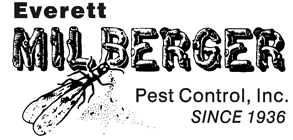Unwanted Houseguests
Fall is right around the corner, and it’s time to ready your home against overwintering pests who seek harborage from the cold by nesting in wall voids of homes and other structures.
- Inspect your home, inside and out. Start by inspecting for cracks and crevices along window and door frames, building corners, etc.
- Look high and low. Grab a ladder to view attic vents and soffits. Any light or air currents penetrating the inside of the attic need to be sealed or screened. An extendable mirror is a great tool for viewing hard-to-see places.
- Check around all utility boxes, pipes, and wires. Any “hole” on the outside of a building is susceptible to pest entry, especially those larger than the width of a pencil.
- Silicone caulk or sealants work great for closing up minor gaps, especially around AC lines. Do not use expandable foam because it can degrade over time and it is easy for mice and other rodents to gnaw right through it.
- Hardware mesh, like the kind used on door and window screens, can be nailed or stapled in place behind vent openings or covers to prevent pest entry.
We can help you with preventative treatments. Call us for an appointment today!
Experts Advise Public to Take Caution During Peak Mosquito Season
A number of states have reported cases of West Nile virus in 2013 as experts warn of the potential for a second consecutive year of increased activity for the virus. The predictions are based on the hot, dry weather conditions in many regions that could resemble 2012, a year that produced the most West Nile virus deaths in U.S. history.
According to a U.S. Centers for Disease Control and Prevention report, 2012 West Nile virus activity included 5,674 total cases of the disease in people and 286 deaths. Total reported cases were the second highest ever since the disease was first tracked in the U.S. in 1999, and the number of deaths was the highest ever. The CDC report cited higher than usual temperatures in 2012 as a likely factor in the record-high West Nile virus activity as hot and dry conditions are ideal for the breeding of Culex mosquitoes and lead to more interactions between birds and mosquitoes sharing limited water pools.
While mosquito control efforts are predominantly the responsibility of mosquito abatement districts and public health departments, people can take actions to help control mosquito activity. There are a number of precautions people in the community can take around their homes, including:
- Turning over pails and emptying planters or anything that can hold stagnant water, allowing mosquitoes to breed
- Changing and maintaining the water in ornamental ponds, birdbaths, wading pools and other receptacles that require water to function
- Practicing good sanitation around the home as litter and debris in the yard can collect water and enable mosquito breeding
- Covering openings for standing water sources, such as septic tanks, rain barrels, and catch basins with fine mesh screening
- Clearing gutters in the spring and fall
- Filling natural depressions in landscaping, tree holes and rotten stumps with sand to absorb water retained after rainfall
- Draining abandoned pools or treating regularly with chlorine to deter egg-laying mosquitoes
- Draining water from tire swings and other backyard play sets and drilling holes in the bottom to help with drainage
- Watering lawns and gardens minimally to prevent puddles and to conserve water
- Mowing tall grass to reduce shady areas where mosquitoes prefer to rest
